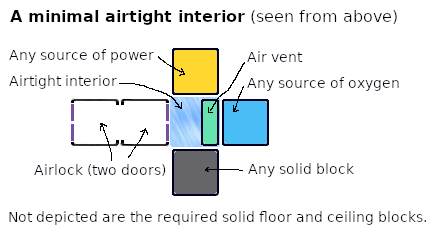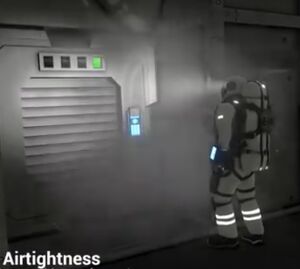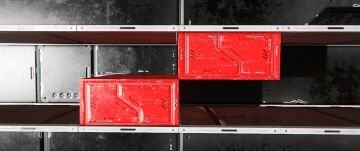Airtightness
An airtight room is an oxygen filled grid interior in which engineers can survive with their helmets open, even outside of a planetary atmosphere.
Pressurised rooms
Pressurized rooms allow engineers to survive without using up the oxygen and electricity reservoirs of their suit. If "Auto-healing" is enabled in the World Settings, player health slowly increases in pressurised rooms as well.
Similarly, the engineer can also survive inside enclosed cockpits as long as oxygen is provided to it with conveyors.
![]() Air Vents are a key building block for airtight rooms.
Air Vents are a key building block for airtight rooms.
How to get oxygen
On planets with atmospheres containing oxygen, the accessible amount of oxygen is unlimited and can be collected with Air Vents that are set to Depressurize mode. Otherwise, oxygen has to be either generated from ![]() Ice in an
Ice in an ![]() O2/H2 Generator, or generated from sunlight with
O2/H2 Generator, or generated from sunlight with ![]() Oxygen Farms.
Oxygen Farms.
How to build airtight rooms
When building airtight rooms using an Air Vent, consider the following rules:
1. Walls:
- Airtight interiors can be built in any shape and size, but must be fully enclosed by solid faces of airtight blocks.
- Closed Cockpits (that is, not open Rover and Buggy Cockpits) count as self-contained, single-block airtight interiors.
- Voxels (the planet or asteroid surface) are not airtight!
2. Airlocks: A pressurised room with a single closed door can technically be airtight, but without an airlock, it will be extremely wasteful of oxygen and power every time the door opens.
- Airtight rooms need airlocks so engineers can exit and enter without venting (wasting) the oxygen.
- The simplest airlock is a pair of closed
 Sliding Doors back to back. Engineers open and close the first door, then open and close the second door. The room stays pressurised and loses only two blocks’ worth of oxygen.
Sliding Doors back to back. Engineers open and close the first door, then open and close the second door. The room stays pressurised and loses only two blocks’ worth of oxygen. - You can optimise a custom-built airlock to depressurise itself and not lose any oxygen.
- The simplest airlock is a pair of closed
- Airlock opening and closing can be automated with sensors and Timers.
3. Air Vents:
- Airtight rooms need at least one Air Vent block in their wall to be pressurized. Several air vents are faster together.
- The Air Vent must be facing into the room, must be powered, and must be conveyored on the back to an oxygen supply (a filled oxygen tank, H2/O2 Generator, or Oxygen Farm).
- To fill the room with oxygen (that is, to “pressurise” it), switch "Depressurize" off in the Vent’s control panel.
How to build an airlock
From simplistic O2 wasting builds to the highly complex oxygen conserving multi-part airlock, many variations exist and they can get very complex, very quickly.
- Better Airlock Aragath has designed an airlock using the Event Controller. Subscribe to the blueprint on Steam.
- "Auto Airlock - The basics in 2022" guide by Dan2D3D
- Automatic Airlock build: screenshots on imgur
Blocks That Are Airtight
- Interior walls, full armor cubes, 1x1x1 cargo containers, conveyor junctions, conveyor sorters, blast door block, ...
- Both assemblers, large O2/H2 generator, jump drives, merge blocks, timers, parachute hatch, small artificial mass, collector, batteries, small hydrogen tank, ...
- Doors form an airtight seal when closed; the
 Sliding Doors bring their own airtight side walls with them, other doors don’t.
Sliding Doors bring their own airtight side walls with them, other doors don’t.
Blocks That Can Be Rotated to Be Airtight
Airtight on at least one side, if rotated to the side with a full face:
- Sloped armor corners and half blocks, some windows, catwalks, air vents, non-grated stairs, window walls, survival kit, safe zone, both refineries, remote control, small O2/H2 generator, small oxygen tank
- The backside blocks of: thrusters, wheels suspensions, laser antennas, oxygen farms, ore detectors, most cockpits, small ship tools, small gatling gun, autocannon, ship-based rocket launchers.
- Certain furniture blocks such as bed, bathroom, toilet, shower, armory, locker, passages, contracts block, dispensers, store
 Airtight Hangar Door: A non-airtight 1x1x1 block that can extend and become an airtight 1x3x1 block when closed; place several in a line to build large airlocks with custom widths.
Airtight Hangar Door: A non-airtight 1x1x1 block that can extend and become an airtight 1x3x1 block when closed; place several in a line to build large airlocks with custom widths.- Offset Doors must be closed and surounded by airtight walls. Somewhat buggy as far as airtightness is concerned.
- Gates and
 Sliding Doors must be closed and directly touching airtight walls.
Sliding Doors must be closed and directly touching airtight walls.
Blocks That Cause Leaks
Many blocks are considered leaky and cannot be used in the outside wall of airtight rooms. They can still be used inside the rooms without any problems. In general you can tell if blocks do not form a contiguous surface — because they are rounded, because they don't fill a solid block-face, or because they have visible holes along the edges — these blocks will cause leaks.
- unwelded blocks are not airtight
- any obvious gaps or missing blocks cause leaks
- open doors, curved and straight conveyors, 5 sides of connectors/small connectors, blast door corners and edges
- gyroscopes, all reactors, both gravity generators, hydrogen engine, cryo chamber, survival kit, medical room, programmable block, solar panels, wind mills, antennas, decoys, war head, upgrade modules, small hydrogen thrusters, large artificial mass(?).
- piston, rotor, large hinge
- vertical and diagonal windows, barred windows, grated stairs, railings, cover walls
E.g. a triangular window pane against the standard 45 degree slope armor is not airtight. - all ship weapons and large tool blocks, landing gears, tanks, wheels.
- all non-full blocks: thin or round armor corners/slopes/tips; button and control panels; sensors, cameras, sound blocks; all seats; control stations; medical station, beacon, vending machines, ATM
- furniture: lights, couches, desks, passenger seats, kitchen, LCDs, console block, planter, ladders, pillars
How to tell which blocks are airtight?
Unfortunately there's no built-in way to do this in the game. You have to either use a mod or guess based on how it looks and through trial and error.
Some mods that will help:
- Leak Finder - Pathfinds from airvent to exterior of the ship, pointing out all the leaking blocks on the way.
- BuildInfo - While holding or aiming at a block you can cycle overlay mode (
ctrl +) to see airtightness faces for it.
How airtightness works internally
First some definitions:
- "Cell" is a 1x1x1 cube slot on a grid where a block or part of a block can exist. Blocks larger than 1x1x1 cover multiple cells.
- "Cell face" being one of the 6 sides of the cell cube.
The airtightness rules:
- Independent per Grid, meaning other grids or Voxels cannot seal an otherwise open-sided grid.
- Blocks in construction stage are never airtight.
- Each cell face can only be either airtight or not.
- Only block's exterior cell faces can be airtight, the inner ones cannot.
For example, half blocks placed in this configuration will still allow air to pass left/right because their independent sealing on that axis is not airtight.
- https://support.keenswh.com/spaceengineers/pc/topic/offset-door-has-wrong-airtight-behavior
- https://support.keenswh.com/spaceengineers/pc/topic/23777-pressurization-discrepancies-in-block-behaviors-as-part-of-a-pressure-boundary
- https://support.keenswh.com/spaceengineers/pc/topic/airtightness-around-gates-and-hangar-doors-when-running-programmable-block-script



